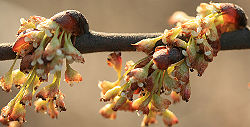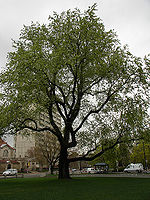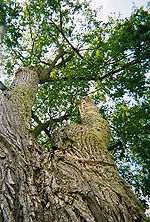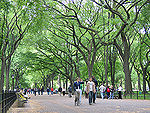American elm
| American elm |
|---|
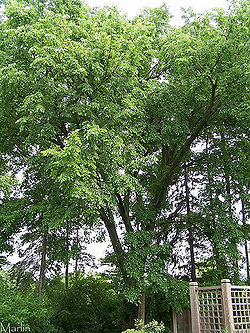
|
| Scientific Classification |
|
| Binomial Name |
|
Ulmus americana |
| American Elm in bloom |
The American Elm is a species of deciduous trees with the scientific name Ulmus americana. They are also known as White Elm, Water Elm, Soft Elm, or the Florida Elm. They are known for their fast grown and long life span, with some reports identifying lengths of longer than 300 years.[1] They are located on the eastern region of North America and some areas in Canada,[2] and can handle stress and temperature change better than other trees.[3] These characteristics generated popular use along the sides of many roads until the spread of the Dutch Elm Disease. This fungal pathogen, which is spread by the elm bark beetle, killed many stands of American elms and reduced their value when consumers learned of the vulnerability to disease.[4]
Anatomy
The height of the American Elm depends on were it is planted. An American Elm located in thick forests can grow up to a height of about 200 feet as an elm located in poor soil will only grow to be about sixty feet tall. The roots of the American Elm also depend upon the type of soil it is planted in. In a well moisturized area, the roots of the American Elm spread out,but in soils that lack water the American Elm develops a taproot.[5] The color of the elm's bark is dark-gray brown color. As the tree matures it develops either an umbrella shaped trunk, or a vase shaped trunk. The American Elm retains a very consistent quality staying medium coarse throughout the year. The leaf of the American Elm grows to a length of three to six inches. The color of the leaves are a green color that are darker on top than on bottom and during the fall the color of the leaves turn yellow. The color of the flowers that it produces can be greenish-red or brown. The color of the fruit is green and later turns into a tan color. [6]
Reproduction
The American Elm usually goes through flowering, seed ripening, and seed fall during spring. Swelling of the buds may differ from tree to tree depending on where it is located. An American Elm located in the South will begin to swell in February, but an American Elm in Canada will begin to swell in May. Seed fall in American Elms is generally done by March, if the elm is located in the south, and June, if the elm is located in the north, but before the seeds fall, wind pollination and fruit ripening take place. American Elms produce a plethora of seeds when they are mature. The manufacturing of seeds in the American Elm may commence when the tree is as young as fifteen years old, but rarely is there any serious seed production in the American Elm before it is forty years old. After the seed falls, it will begin to germinate. It begins growing above the ground. Sometimes the seed won't begin germinating until the next spring. The period in which the seed germinates can last as long as sixty days, though a lot of the seeds will have finished germination in six to twelve days. They may also go through vegetative reproduction in which the elm will create stump sprouts.[7]
Ecology
The American Elm is native to the eastern part of the United States and can also be found in parts of Canada. The American Elm is generally found on the bottom and flat regions of where it exists, but it is not limited to these areas. In the south east area of which it inhabits, it does not live in swamps, but is found in bottoms, flats and terraces. They are also found in higher elevations such as the Appalachian Mountains, but grow around big streams. They are able to live in a wide variety of areas such as well drained sands, organic bogs, undifferentiated silts, poorly drained clays, and prairie loams. Among all these the American Elm develops better in rich, well drained loams. Water in the soil also affects how well the elm grows. If the water is well moisturized it will grow well, on the contrary if it is dry it will not grow as well. [8]
Uses
The Dutch Elm Disease, is a disease that causes the elm tree to fill its xylem tissue with materials which prohibits water and dissolved minerals to be delivered upward into the tree. These disease has decreased the value of some elms and makes them an undesirable tree. The American Elm used to be treasured for its beautiful vase-like crown, how well it puts up with stress, and its ability to develop quickly. Its occupancy was being an ornament to decorate the streets. Besides being a street tree, it can also be used as a hockey stick because of how hard and durable the wood is, as furniture, flooring, hardwood dimension, construction and mining timber, and sheet metal work. Parts of the wood are used for the development of boxes, crates, and baskets. Small portions of the wood are also used to make pulp and paper.[9] The American Elm is also used for medicinal purposes such as being a demulcent, an astringent, a diuretic, and is also used to treat burns, cold sore, and inflammation.[10]
Gallery
References
- Habitat Calvin F. Bey
- Characteristics Index of Species Information
- Facts SOS Elms
- Form American Elm
- Taxa USDA
